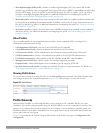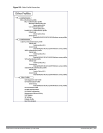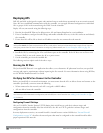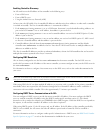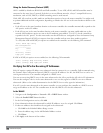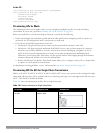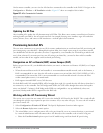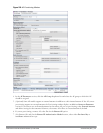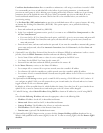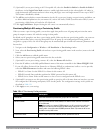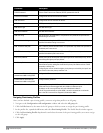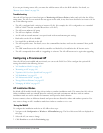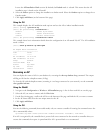
On the master controller, you can view the APs that have connected to the controller in the WebUI. Navigate to the
Configuration > Wireless > AP Installation window. Figure 117 shows an example of this window.
Figure 117: APs Connected to Controller
Updating the RF Plan
After installing APs, update the AP placement map in RF Plan. This allows more accurate reconciliation of location
tracking features provided by the user-centric network—for example, locating users, intruders, rogue APs and other
security threats, assets, and sources of RF interference—with the physical environment.
Provisioning Installed APs
The two most common ways to provision an AP for remote authentication are certificate-based AP provisioning and
provisioning using a pre-shared key. Although both options allow for a simple secure setup of your remote network,
you should make sure that the procedure you select is supported by your controller, the AP model type and the end
user’s client software. If you must provision your APs using a pre-shared key, you need to know which controller
models you have that do not support certificate-based provisioning.
Designation an AP as Remote (RAP) versus Campus (CAP)
Before you provision an AP, you should decide whether you want it to function as a Remote AP (RAP) or a Campus
AP (CAP).
l When the network between the AP and controller is an un-trusted/non-routable network, such as the Internet, a
RAP is recommended; in cases where the AP needs to connect over private links (LAN, WAN, MPLS), a CAP is
recommended. The reason that CAP is not recommended over a non-routable network is because the IPsec
within control plane security is in tunnel mode.
l RAP supports internal DHCP server; CAP does not.
For both RAPs and CAPs, tunneled SSIDs will be brought down eight (8) seconds after the AP detects that there is
no connectivity to the controller. For CAP bridge-mode SSIDs, the CAP will be brought down after the keepalive
times out (default 3.5 minutes). RAP bridge mode SSIDs are configurable to stay up indefinitely (always-on /
persistent). Backup mode SSID is supported on the RAP only.
Working with the AP Provisioning Wizard
The easiest way to provision any remote AP is to use the ArubaOS AP Wizard in the WebUI. This wizard will walk
you through the specific steps required to provision a remote AP (or any other AP type). To access the AP wizard to
provision a remote AP:
1. Select Configuration>Wizards>AP Wizard. The Specify Deployment Scenario window appears.
2. Select the Remote deployment scenario option.
3. The wizard allows you to configure remote APs to be provisioned by a user at a remote location, or provisioned
by a network administrator who will connect those APs directly to the controller as the wizard is being run.
l Select the User-Provisioned option to provision AP models using certificate-based AP provisioning.
DellPowerConnectW-SeriesArubaOS6.2 | User Guide AccessPoints(APs) | 409



